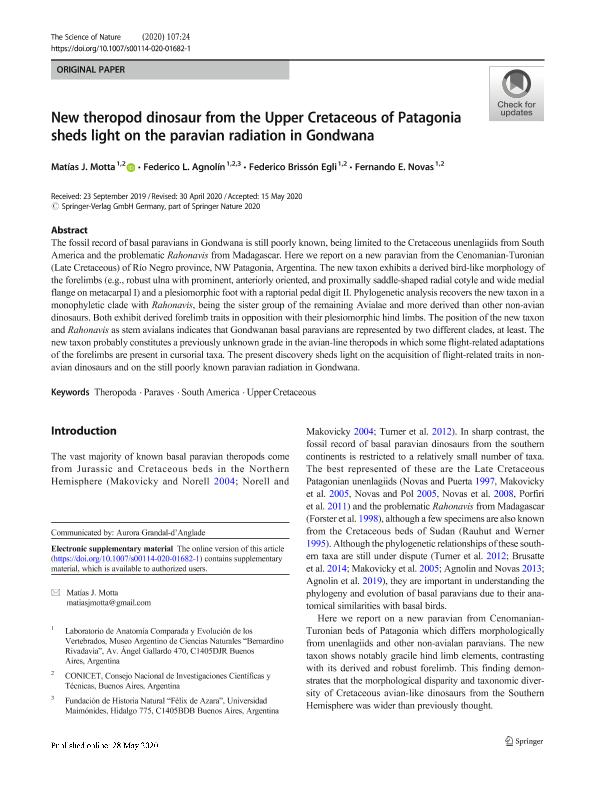Artículo
New theropod dinosaur from the Upper Cretaceous of Patagonia sheds light on the paravian radiation in Gondwana
Fecha de publicación:
06/2020
Editorial:
Springer
Revista:
The Science of Nature
ISSN:
0028-1042
Idioma:
Inglés
Tipo de recurso:
Artículo publicado
Clasificación temática:
Resumen
The fossil record of basal paravians in Gondwana is still poorly known, being limited to the Cretaceous unenlagiids from South America and the problematic Rahonavis from Madagascar. Here we report on a new paravian from the Cenomanian-Turonian (Late Cretaceous) of Río Negro province, NW Patagonia, Argentina. The new taxon exhibits a derived bird-like morphology of the forelimbs (e.g., robust ulna with prominent, anteriorly oriented, and proximally saddle-shaped radial cotyle and wide medial flange on metacarpal I) and a plesiomorphic foot with a raptorial pedal digit II. Phylogenetic analysis recovers the new taxon in a monophyletic clade with Rahonavis, being the sister group of the remaining Avialae and more derived than other non-avian dinosaurs. Both exhibit derived forelimb traits in opposition with their plesiomorphic hind limbs. The position of the new taxon and Rahonavis as stem avialans indicates that Gondwanan basal paravians are represented by two different clades, at least. The new taxon probably constitutes a previously unknown grade in the avian-line theropods in which some flight-related adaptations of the forelimbs are present in cursorial taxa. The present discovery sheds light on the acquisition of flight-related traits in non-avian dinosaurs and on the still poorly known paravian radiation in Gondwana.
Palabras clave:
PARAVES
,
SOUTH AMERICA
,
THEROPODA
,
UPPER CRETACEOUS
Archivos asociados
Licencia
Identificadores
Colecciones
Articulos(MACNBR)
Articulos de MUSEO ARG.DE CS.NAT "BERNARDINO RIVADAVIA"
Articulos de MUSEO ARG.DE CS.NAT "BERNARDINO RIVADAVIA"
Citación
Motta, Matias Javier; Agnolin, Federico; Brissón Egli, Federico; Novas, Fernando Emilio; New theropod dinosaur from the Upper Cretaceous of Patagonia sheds light on the paravian radiation in Gondwana; Springer; The Science of Nature; 107; 3; 6-2020; 1-8
Compartir
Altmétricas




